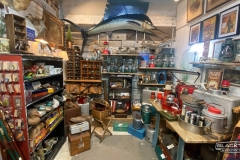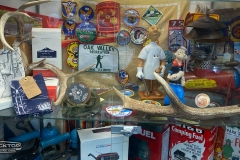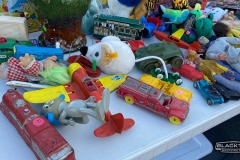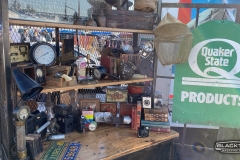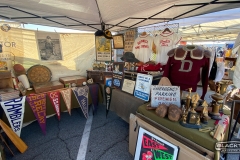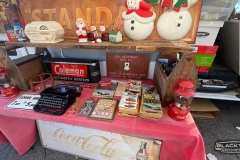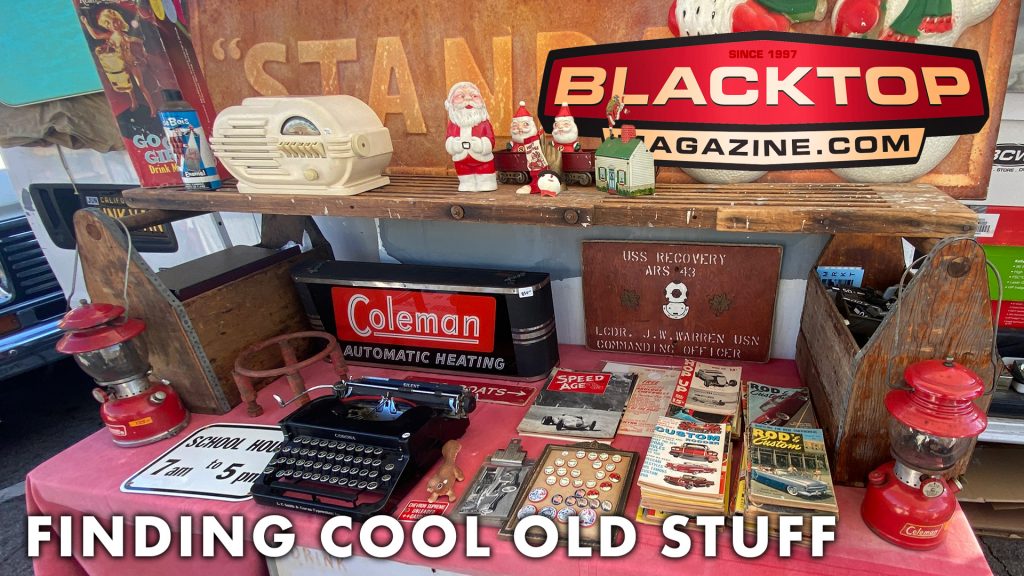
Sometimes I feel like an archeologist. Yeah, Indiana Jones for sure. OK, maybe not that adventurous, but I sure dig finding some cool old stuff. It doesn’t take much to get me going either. I was watching a docu-drama on History channel when they were talking about the depression of the 1930’s a family was getting into a Ford sedan. From the view of the rear of the car, you can plainly see the license plate and cool topper. Like a crack of Indy’s whip I thought, I gotta find me that topper. (pictured below).

There are many ways to go after this tin piece of sh-antiquery… Sure I can get all glassy eyed by searching online auctions. I can beat the pavement to antique malls and stores or get up at the crack to be the first in line at an estate sale. But the most fun, is when you are invited over to a personal garage sale, or when it falls in your lap as a bundle of other stuff you bought or was gifted.
Here’s a bit more detail on ways to Find Cool Old Stuff:
- Antique Shops and Malls: Many cities and towns have antique shops or malls where dealers showcase a variety of vintage items. These can range from furniture and clothing to collectibles and artwork.
- Flea Markets: Flea markets are excellent places to discover a wide array of vintage items at more affordable prices. Vendors often sell unique pieces, and bargaining is often part of the experience.
- Estate Sales: Estate sales are organized to sell the belongings of individuals who have passed away or are downsizing. These sales often feature a mix of everyday items and unique collectibles.
- Thrift Stores: Thrift stores, including national chains and local shops, are treasure troves for vintage finds. Prices are generally lower, and the selection can be diverse.
- Garage Sales: Local garage sales or yard sales can yield hidden gems. Since prices are often negotiable, you may find some cool items at a bargain.
- Auctions: Attend local auctions or online auctions to bid on vintage items. This can be a competitive but rewarding way to acquire unique pieces.
- Online Marketplaces: Websites like eBay, Etsy, and Ruby Lane are popular online platforms where you can find a vast selection of vintage items. Make sure to check the seller’s reputation and read reviews.
- Specialty Shows and Fairs: Look for antique and vintage shows, flea markets, or fairs in your area. These events often attract dealers and collectors from different regions, offering a diverse selection of items.
- Collector’s Clubs: Joining collector’s clubs or online communities focused on specific types of vintage items can be a great way to connect with fellow enthusiasts. Members often share information about where to find unique pieces.
- Auction Houses: Higher-end or specialty items may be found at auction houses that specialize in art, antiques, or collectibles.
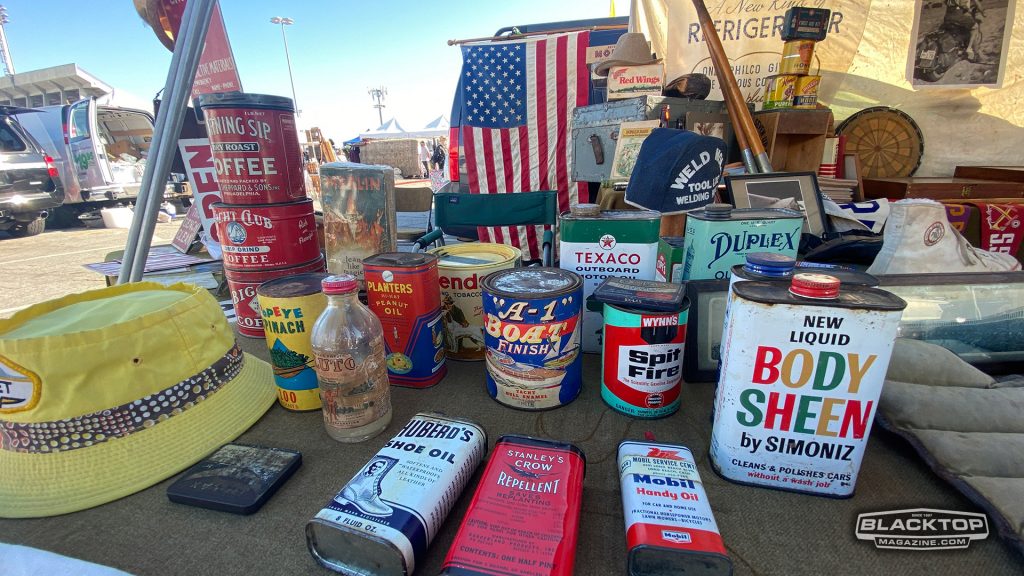
People collect vintage items (or Cool Old Stuff) for various reasons, and the motivations can be diverse and personal. I like the challenge of the hunt.
- Nostalgia: Vintage items often evoke a sense of nostalgia, reminding collectors of a bygone era or a time from their past. People may collect items that were popular during their childhood or a period they romanticize.
- Historical Interest: Collectors may be drawn to vintage items because of their historical significance. These items serve as tangible artifacts that provide a connection to the past, helping people learn about and appreciate history.
- Aesthetic Appeal: Vintage items often possess unique and distinctive designs that appeal to collectors’ aesthetic sensibilities. Whether it’s clothing, furniture, or other artifacts, the craftsmanship and design of vintage items can be visually captivating.
- Investment: Some collectors view vintage items as investments. Certain items may appreciate in value over time, especially if they become rare or highly sought after. Collecting can be seen as a form of asset accumulation.
- Environmental Consciousness: Collecting vintage items can be a sustainable and environmentally conscious choice. Reusing and repurposing older items can help reduce waste and promote a more sustainable lifestyle.
- Cultural Connection: Vintage items often carry cultural significance. Collectors may be drawn to items that reflect the culture and trends of a particular era. It can be a way to preserve and celebrate cultural heritage.
- Hobby and Passion: Collecting can be a fulfilling hobby and a way for individuals to express their passions. It provides a sense of accomplishment and a way for enthusiasts to immerse themselves in their interests.
- Storytelling and Memory: Each vintage item has its own story and history. Collectors may enjoy uncovering the stories behind their items and sharing these narratives with others. It becomes a way of preserving and passing on memories.
- Community and Socializing: Collecting often involves a community of like-minded individuals who share a common interest. Whether through online forums, local clubs, or events, collectors can connect and socialize with others who appreciate the same vintage items.
- Personal Connection: Some people collect vintage items because of a personal connection to a specific era, style, or cultural movement. It becomes a way for individuals to express their identity and interests.
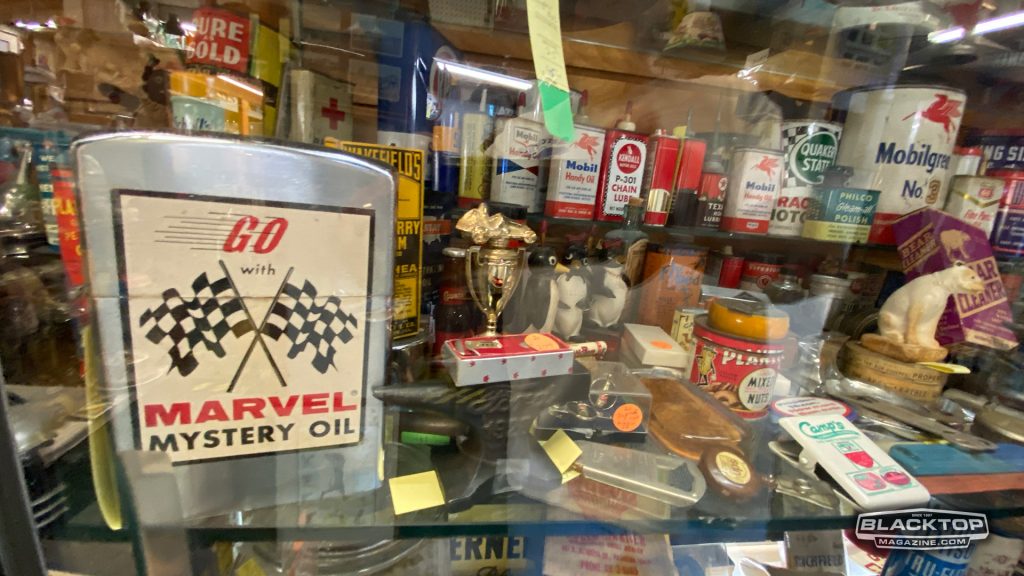
While collecting vintage items can be a rewarding hobby, it does come with its own set of challenges. Here are some common challenges that collectors may face when trying to find cool old stuff:
- Scarcity: As items age, they often become more scarce, especially if they were produced in limited quantities. Finding certain vintage items can be a challenge due to their rarity.
- Condition: Vintage items may suffer from wear and tear over time. Finding items in good condition, or restoring them to a satisfactory state, can be a significant challenge. Damage, fading, and deterioration are common issues.
- Authentication: With the market for vintage items growing, there’s an increased risk of encountering replicas or counterfeit items. Authenticating vintage pieces, especially those from popular brands, can be a challenge and requires knowledge and expertise.
- High Demand: Some vintage items are highly sought after, leading to increased competition among collectors. This high demand can drive up prices and make it more difficult to find affordable pieces.
- Limited Information: Tracking down information about specific vintage items, such as their history, origin, or production details, can be challenging. Limited documentation and records for older items can make research more difficult.
- Market Fluctuations: The value of vintage items can be subject to market fluctuations. What may be highly valued at one point could see a decrease in demand or value in the future, affecting the overall market for certain items.
- Storage and Preservation: Storing and preserving vintage items can be a challenge, especially if they are delicate or susceptible to environmental factors like humidity, temperature, and light. Proper storage is crucial for maintaining the integrity of collectibles.
- Transportation and Shipping: Vintage items, especially larger or fragile ones, may be challenging to transport safely. Shipping delicate items requires careful packaging and handling to prevent damage during transit.
- Changing Trends: The popularity of certain vintage items can be influenced by changing trends and tastes. What is considered “cool” or desirable may shift over time, impacting the market for specific collectibles.
- Ethical Considerations: Some collectors may face ethical dilemmas, especially if they collect items with cultural or historical significance. Ensuring that items are obtained ethically and with proper respect for cultural heritage can be a challenge.
Despite these challenges, many collectors find the process of hunting for cool old stuff to be part of the thrill of the hobby. Overcoming these obstacles adds to the satisfaction of discovering and acquiring unique pieces with a history of their own.
Remember to keep an open mind, be patient, and enjoy the process of searching for cool old stuff. Each place has its unique charm and offerings, so exploring a variety of options can lead to exciting discoveries.

